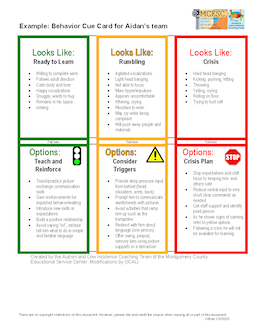Autism Center Grab and Go Resource Gallery of Interventions
Behavior Cue Cards for Staff
Discover Behavior Cue Cards for Staff. These cards are NOT to be viewed or utilized by students but, rather are used by staff to ensure that all adults are responding to an individual's behavioral needs in a positive, appropriate, and consistent manner. Often, staff may lack a clear understanding of the social/communication/emotional needs of a student and how it affects behavior(s). Behavior Cue Cards can help to promote a clearer understanding of why a behavior may occur and then provide specific strategies based on that understanding. All staff (teacher, intervention specialist, occupational therapist, speech language pathologist, paraprofessionals, etc.) can use these cards to know how to respond to a student at different levels of emotion and regulation to avoid escalating behaviors.
These cards are organized to represent 3 different levels of emotional regulation. The front of the cards are color coded. Green represents Ready to Learn, Yellow represents Rumbling, and Red represents Crisis. The back of the cards provides interventions and strategies to use at each level.
To use the cards, cut out each color and fold to fit into a baseball card protector.
Please view the OCALICON 2022 video (Listed below) to learn more about how to use this helpful tool.
This tool was created by the Autism and Low Incidence Coaching Team from Montgomery County Educational Service Center in Dayton, Ohio.
Examples

Behavior Cue Cards for Staff
- Example 1: Behavior Cue Cards for Staff Aidan Example
- Example 2: Behavior Cue Cards for Staff Blank Template
- Example 3: Behavior Cue Cards for Staff Cammie on the bus Example
- Example 4: Behavior Cue Cards for Staff Jacoby Example
- Example 5: Behavior Cue Cards for Staff Kamal Example
- Example 6: Behavior Cue Cards for Staff Kennedy Example

Autism and Difficult Moments: Practical Solutions for Reducing Meltdowns
Myles, Brenda Smith
This book offers tried-and-true solutions to minimize and circumvent the often frightening circumstances that surround the rage cycle, not only for the child with high-functioning autism, but for others in the environment as well. A highly practical and user-friendly resource, High-Functioning Autism and Difficult Moments, focuses on the reactions of adults around the child. The authors take the reader through the stages of the rage cycle and emphasize the importance of utilizing the teachable moments before and after a rage episode.